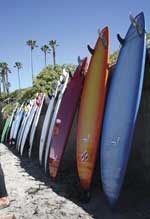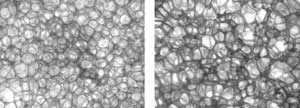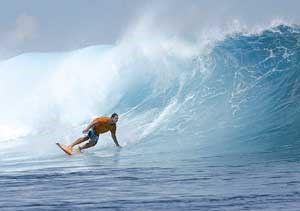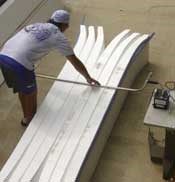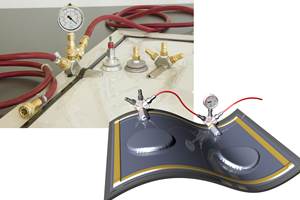Waves Of Change: From Shock To Opportunity
Closing of Clark Foam opens surfboard industry to new technologies.
In the surfing world, it's called a wipeout.
On Dec. 6, 2005, Clark Foam (Laguna Niguel, Calif.) - the supplier of 80 percent of the polyurethane foam blanks that form the cores of the world's composite surfboards - abruptly closed its doors after 40 years. Citing serious legal difficulties with local environmental and fire regulators, owner Gordon "Grubby" Clark (the nickname acquired during his early surfing days) went into seclusion while stunned surfboard manufacturers scrambled to find new sources (see the CompositesWorld.com Weekly e-newsletter, March 14, 2006, http://www.compositesworld.com/news/cwweekly/2006/ March/cw110356).
A chemical engineer as well as a surfer, Clark had spent years refining the dense, fine-celled, creamy white, molded polyurethane foam and blank designs coveted by surfboard shapers the world over in what is estimated to be a $200 million dollar (USD) industry in the U.S. alone. But by mid-March this year, Clark employees had destroyed the company's 90 concrete molds and auctioned off its manufacturing equipment.
In the first half of 2006, shock gave way to opportunity, as a diverse group of entrepreneurs and established surfboard suppliers moved quickly to fill the product pipeline. Predictably, polyurethane blank manufacturers are springing up to fill Clark's legendary foam-filled shoes, but others are banking that the polyurethane drought will permit alternative foam technologies to find a following, as well.
Success Tied to Formula
A former world champion surfer and founder/owner of Surfblanks (Sydney, Australia), Midget Farrelly is a staunch defender of polyurethane blanks. "Cell production at low densities is key to the game," he explains. "If you can make a very light blank that is very fine celled and has reasonable structural integrity and allows good adhesion between the polyester resin and the outer layers of the foam, you have a winner." Clark was successful because he was able to turn out more than 800 of this type of blank each day with very few rejects. He also had developed a reliable distribution network, especially in the U.S., Farrelly notes, but suggests, "Once the trauma has gone from having no blanks at all, people ... will begin to sample blanks made elsewhere."
Farrelly bought a substantial share of Clark Foam's foam-making equipment and is now one of at least six Australian blank manufacturers seeking to attract former Clark customers. Facing environmental requirements similar to those in the U.S., Farrelly says Surfblanks is in compliance today and plans to do what is necessary to satisfy regulatory bodies in the future. His polyurethane chemistry is based on toluene diisocyanate (TDI), as was Clark's, but Farrelly points out that TDI is commonly used in products such as car upholstery and carpets. "Polyurethane surfboard blanks are not going to disappear, and TDI is not going to disappear," he maintains. "We just have to learn to handle it better."
Farrelly offers eight densities, from one slightly lighter than Clark's lightest, to all the heavier densities that Clark offered.
Back to the Future - The New Old Polyurethanes
Bob Lockwood, senior development associate for Huntsman Polyurethanes (Auburn Hills, Mich.), which along with The Dow Chemical Co. (Marietta, Ga.) and Bayer MaterialScience (Pittsburgh, Pa.) manufactures polyurethane, explains that board blanks can be made with a two-component system, using (1) an isocyanate - either TDI or an alternative chemistry, diphenylmethane-4.4'-diisocyanate (MDI) -and (2) either a polyester or polyether polyoyl blend. MDI is considered by some to be less toxic than TDI, but both are subject to U.S. Occupational Safety and Health Admin. (OSHA) exposure standards. Further, Clark Foam's blanks were polyester urethane, but Lockwood says polyether is not only less expensive but more hydrolytically stable (it doesn't degrade as quickly over time when exposed to water).
To make foam blanks, the two components are poured into an open blank mold and the mold is closed for processing. Typically, the foam is cured by exotherm heat, but in some cases the mold is heated. Water is the primary blowing agent for processing polyurethane foam, but auxiliary blowing agents, such as methylene chloride, acetone, hydrochlor fluorocarbons and isopentane low-temperature boiling solvents can be used to make the foam softer and lighter.
Elliott Co. of Indianapolis (Indianapolis, Ind.), is one of several companies marketing an MDI/polyester urethane foam. "We're in R&D on this, now, talking to key shapers and tweaking and developing a formula specifically designed for board applications," says Bryan Elliott, president. While Clark supplied a molded near-net blank, Elliott processes tight, fine, closed-cell block foam, typically 20-inches/61-cm thick and 4-ft/1.2m wide, on a continuous basis, blown with "environmentally responsible hydrocarbon," Elliott says. The blocks can be cut to any size specified and come in densities of 2-, 3-, 4- and 6-lb/ft3 (0.03-, 0.05-, 0.06- and 0.1-g/cm3).
Ice-Nine Foam Works, a startup in Orange County, Calif., is developing not only proprietary MDI-based polyurethane chemistries butnew dispensing, metering and molding technologies as well, for what company president Jon Stillman says will be a production approach markedly different than the one employed by Clark Foam. Ice-Nine's MDI formula is much lower in toxicity, he points out, and the fumes from the company's water-blowing process have a much lower VOC rating. Ice-Nine's initial product is polyester urethane, but polyether formulas also are being evaluated.
"We have developed the ability to control the foam properties, aiming to offer the market more options - especially the ability to control hardness and softness independently of density," Stillman says. Ice-Nine is supplying densities in the range of 3 lb/ft3 to 7 lb/ft3 (0.05 g/cm3 to 0.11 g/cm3). The lightest densities will match those of Clark Foam, while heavier densities will be available for manufacturers of tow-in boards and skimboards. Stillman adds, "Of course, we will work closely with our customers to dial in the exact properties that best serve each application."
In the four months following the Clark closure, startup Just Foam (San Clemente, Calif.) grew from 3 to 26 employees and from 25 to 150 blanks produced daily on the strength of founder/president Scott Saunders' proprietary hybrid-TDI chemistry, which reportedly meets environmental regulations with unusually low VOC emissions. Just Foam pours two-part urethane into rocker-shaped closed molds and cures "hundreds of blanks at a time" in an oven for more than an hour. At press time, 2.8 lb/ft3 and 3 lb/ft3 (0.04 g/cm3 and 0.05 g/cm3) molded densities were available.
In one of the more unusual developments, researchers at Sandia National Laboratories (Livermore, Calif.) are marketing TufFoam, a low-density (from 2 lb/ft3 or 0.03 g/cm3), water-blown, modified MDI/polyether urethane foam. A National Nuclear Security Admin. (NNSA) lab, Sandia originally conceived TufFoam as a means of protecting sensitive electronic and mechanical structures in harsh military environments. LeRoy Whinnery, polymer chemist for Sandia, explains, "The water reacts with isocyanate in the modified MDI to make carbon dioxide (CO2), which, in turn, reacts to expand the foam." Sandia emphasizes that TufFoam contains no TDI, the chemical identified by Gordon Clark as the focal point of his legal difficulties.
Sandia recommends ~150°F/~65.5°C cure of the foam core for about four hours. Test results indicate high impact resistance as well as good strength in compression and bending. Sandia is in licensing discussions with three companies, at least one of which is a current surf industry supplier.
Former shaper Gary Linden, now operations manager of Walker Foam (Wilmington, Calif.), a long-time Clark Foam competitor, admits that Clark's were some of the best engineered blanks in the world, but believes that Walker's TDI-based polyether urethane is denser, with better cell bonding. Comparing the process to making waffles in a waffle iron, he says that, as it expands and rises in a closed mold, "polyether urethane foam gels quicker, so the outside gets harder and the inside lighter." Walker supplies blanks from 2.25 to 3 lb/ft3 (0.04 to 0.05 g/cm3) densities for all levels of surfers. Walker uses concrete molds and water-blown foam expanding technology.
Walker has sold its technology to a Chinese company for production in China but has no plans to set up its own factories in China, Mexico or other offshore locations, according to Linden.
Meanwhile, former Clark Foam employees Kim Thress and Jeff Holtby announced in mid-March the formation of a new company, US Blanks (Los Angeles, Calif.), with partners Ted Wilson of glass and resin supplier Fiberglass Hawaii (Honolulu, Hawaii and Santa Cruz, Calif.) and surfboard designer Gordon Merchant (Billabong Int'l Ltd., Burleigh Heads, Queensland, Australia). Thress and Holtby have assembled a team of long-time Clark senior staffers and ex-Clark production employees, intending to pick up where Clark left off. The company will offer polyurethane foam similar to the Clark product (production of which has been moved to a more suitable location in California). But, for builders preferring to work with expanded polystyrene (EPS) foams, the company also will offer two additional solutions: a molded EPS foam available in various densities, and an extruded polystyrene foam.
Beyond Polyurethane
In the wake of the Clark collapse, polystyrene has gained support from the likes of former world-tour surfer and practicing shaper/designer Dave Parmenter, (Makaha, Hawaii and San Luis Obispo, Calif.), one of a number of blank producers pulling for new technologies. While lamenting the move away from surfing as a cottage industry, which he says promoted innovation, Parmenter says, "We need better engineering and science in the surfboard industry." Parmenter predicts that performance-minded surfers will go to polystyrene blanks and is developing boards made with EPS cores and glass/epoxy laminates. Parmenter will use the 2000 epoxy system formulated for surfboards by Resin Research (Tucson, Ariz.), rather than the typical polyester resin. Founder/owner Greg Loehr's Project 21 System incorporates four epoxy resins and three curing agents. EPS/epoxy boards cost a little more, Loehr says, but if manufacturers do their homework, then they can bring the cost down. "While epoxy is twice the cost of polyester, you use only half as much because there's no solvent," he contends, adding that flex and other board characteristics can be custom tailored through resin selection and reinforcement schedules.
Loehr concedes that numerous challenges plagued the early development of epoxy resins for surfboards: the resin yellowed badly, the original epoxies were very toxic and flex was inconsistent. "We solved these problems through extensive research and testing in the formulation of the resin, and customized the flex systems by developing the four resin formulas along with industry standard baseline fabric schedules," Loehr says.
Parmenter strengthens his EPS core with two layers of 0°/90° woven E-glass or S-glass on both the top deck and the bottom - instead of the standard two layers on the deck and one on the bottom - to resist buckling in high surf.
Rusty Preisendorfer, world class surfer and founder of Rusty Surfboards (San Diego, Calif.), one of the world's biggest polyurethane surfboard labels, also believes EPS/epoxy has a bright future. "EPS pioneers initially used low-density, big bead foam that got a bad rap for being difficult to handshape and notorious for soaking water if dinged," he says. But today, he explains, blanks propoerly processed from smaller polystyrene beads are easier to shape, stronger than comparable polyurethane densities and close to waterproof.
EPS beads are readily available in several sizes, containing 4 to 7 percent blowing agent, usually pentanes or butane. Suppliers include The Dow Chemical Co. (Marietta, Ga.) and Huntsman Advanced Materials (The Woodlands, Texas).
Other blank makers who have stepped up to make shaped, compression-molded EPS blanks include Salomon S-Core (div. of Salomon Sports, Annecy, France), Marko Foam Products (Corona, Calif.), Austin Foam Cores (Huntington Beach, Calif.) and Insulfoam (Chino, Calif.).
Salomon S-Core molds hollow blanks for glass/epoxy boards, using high-density extruded EPS sheet, backed internally with carbon fiber fabric and some polypropylene foam ribbing. The company has pumped considerable resources into developing a lighter, stronger board, with lively flex and moderate durability, with the goal of providing near net-shape blank that shapers can customize.
Marko Foam processes a number of EPS foam types, sizes and grades from Dow and other suppliers. Together with surfboard shaper/builder Surflight (Waialua, Oahu, Hawaii), Marko Foam formed a joint project to develop highly fused, molded EPS blanks in the 4-lb/1.81 kg weight range that, according to Marko Foam president Ty Peterson, "have a really nice flex." Surflight president Jim Richardson, who built his business by engineering board flex, was so pleased with the result that Surflight and Marko Foam now co-market the blanks in three densities, 1.5, 1.9 and 2.3 lb/ft3 (0.024, 0.030 and 0.040 g/cm3), to shapers in Hawaii and the U.S. mainland. They also will offer higher densities for longboards and specialty boards.
In addition, Surflight still makes its original high-performance soft surfboard using a structural blank made with expanded polypropylene (EPP) foam wrapped around an extruded polystyrene core and laminated with epoxy and hybrid glass/carbon fiber. Surflight laminates the core with 0°/±45° stitched multiaxial glass fabric, combined with 0°/90° woven glass cloth. Unidirectional carbon is layed up in key areas on the board bottom to tune the flex response. The fabrics are wet out with Pro-Set epoxy from Pro-Set (Bay City, Mich.) and the board is vacuum-bagged and oven-cured in a temporary rocker tool, made from wood or masonite. The EPP is cut into thin sheets, about 0.5-inch/12.7-mm thick, plus a thicker piece for the rail. These are bonded to the polystyrene core using urethane adhesive. "The inner core is contoured to give the right amount of flex and spring, and acts as a torsion box to eliminate twist," Richardson explains.
Compression Molded Boards Gain Wave Space
Surftech International (Santa Cruz, Calif.; see CT February 2001, p. 45) developed Tuflite, a surfboard manufacturing technology based on the compression molding process. Surftech now subcontracts much of its Tuflite construction to Cobra International (Bangkok, Thailand). Founded in 1985 by its president and former champion windsurfer, Vorapant Chotikapanich, Cobra is currently the main producer of Tuflite surfboards, manufactured to Surftech specifications. Shapers in Australia, Japan, Hawaii, California and along the U.S. East Coast deliver master patterns to Surftech. Surftech specs the boards and Cobra manufactures them using the Tuflite process. The resulting boards are private labeled under shaper brand names.
Tuflite technology is based on a 1-lb/ft3 (0.2 g/cm3) EPS core, using a proprietary woven E-glass (built up for extra strength in the footing area) and an outer layer of PVC foam sheet from DIAB Inc. (DeSoto, Texas), Alcan Airex AG (Sins, Switzerland) and other core material suppliers. The fabric plies are wet out with epoxy resin before layup over the core, and the PVC is layed over the fabric, followed by a final ply of woven fiberglass. This double-sandwich layup then is compression molded in a fiberglass clamshell tool at about 160°F/71°C for two hours.
Surftech offers four different technologies: Standard Tuflite; Tuflite with heavier fiber and a wood veneer lamination; and SoftTop, with a rubber top and heavier, multifiber glass exterior, plus an acrylonitrile styrene acrylate (ASA) bottom sheet instead of gel coat. (ASA is from Pittsfield, Mass.-based GE Plastics.) A new TL2 premier board comes out this summer.
Hollow Surfboards
Omohundro Co. (Tustin, Calif.), Alive Surfing Technology (AST, San Diego, Calif.) and Segway Composites (Colton, Calif.) believe the key to lightweight, high-performance surfboards is making boards hollow, using aerospace composite technology. Segway's Kolstof-brand surfboards, for example, feature sandwich construction on the top (deck) and bottom, with 0°/90° carbon fiber cloth on the outside skin, which contacts the water, an aluminum honeycomb core, and 0°/90° bidirectional woven fiberglass on the inside skin, for impact protection. The boards are layed up by hand with Resin Research 2020 epoxy, and a carbon/ aramid support structure is fabricated and glued in place to stiffen the airfoil, using reinforcements from Graphite Master (Los Angeles, Calif.). (Aramid is not used on the top and bottom skins because of its hydroscopic nature.) The honeycomb core inside the board's top and bottom sandwich panels reportedly ensures board buoyancy, even if the board is punctured and water penetrates into the hollow space between them.
Ken Ebert, Segway founder/owner, says the top and bottom are molded in in-house-built vinyl ester and epoxy open tooling. They're vacuum bagged at 14.8 psi/1.02 bar and 150°F/65.5°C, for about four hours. Segway pulls about 1,000 parts per tool, using Mold Wax #8 from Meguiar's, (Irvine, Calif.).
VOC-Free Foam
L.A.P. Extreme (San Clemente, Calif.), a supplier of foam-cored speed skiing helmets for the U.S. Ski team since 1992, makes and sells both blanks and custom boards for high-performance surfing. Extreme's blanks are made in a reportedly VOC-free process, using the company's proprietary Polyfoam planks. Neither polyurethane nor EPS, says founder/ owner Richard Landingham, the planks range from 3.5 inches to 12 inches (9 cm to 30 cm) thick, 12 inches to 48 inches (30 cm to 122 cm) wide, and up to 12 ft (3.65m) long. They are produced by injecting the foam beads into a closed mold and fusing them together under 300°F/150°C steam heat and 72.5 psi to 116 psi (5 bar to 8 bar) pressure.
To make blanks, a laser scanner is used to input measurements of a shaper's design. Then a near-net or net-shaped blank is produced by cutting a plank into two halves lengthwise and CNC-machining the taper into the foam. A composite or wood stringer is cut in the rocker shape and the blanks and stringer are adhesively bonded in an adjustable jig.
Landingham says the finish is pure white, 100 percent UV stable and won't yellow. Produced in densities from 1.5 to 3 lb/ft3 (0.02 to 0.05 g/cm3), Polyfoam blanks reportedly bend nearly 90° before they break, and flex patterns can be varied within a single board. "We are the only company that offers a one-year warranty against pressure dings," he claims, adding that if the laminate is penetrated, water only wets the outer layer of foam, and if placed in the sun, the board will heat expand and expel the water.
Related Content
Plant tour: Albany Engineered Composites, Rochester, N.H., U.S.
Efficient, high-quality, well-controlled composites manufacturing at volume is the mantra for this 3D weaving specialist.
Read MoreSmartValves offer improvements over traditional vacuum bag ports
Developed to resolve tilting and close-off issues, SmartValves eliminate cutting through vacuum bags while offering reduced process time and maintenance.
Read MoreVIDEO: One-Piece, OOA Infusion for Aerospace Composites
Tier-1 aerostructures manufacturer Spirit AeroSystems developed an out-of-autoclave (OOA), one-shot resin infusion process to reduce weight, labor and fasteners for a multi-spar aircraft torque box.
Read MoreGKN Aerospace, Joby Aviation sign aerostructures agreement
GKN Aerospace will manufacture thermoplastic composite flight control surfaces for Joby’s all-electric, four-passenger, composites-intensive ride-sharing aircraft.
Read MoreRead Next
Plant tour: Daher Shap’in TechCenter and composites production plant, Saint-Aignan-de-Grandlieu, France
Co-located R&D and production advance OOA thermosets, thermoplastics, welding, recycling and digital technologies for faster processing and certification of lighter, more sustainable composites.
Read MoreDeveloping bonded composite repair for ships, offshore units
Bureau Veritas and industry partners issue guidelines and pave the way for certification via StrengthBond Offshore project.
Read MoreVIDEO: High-volume processing for fiberglass components
Cannon Ergos, a company specializing in high-ton presses and equipment for composites fabrication and plastics processing, displayed automotive and industrial components at CAMX 2024.
Read More





